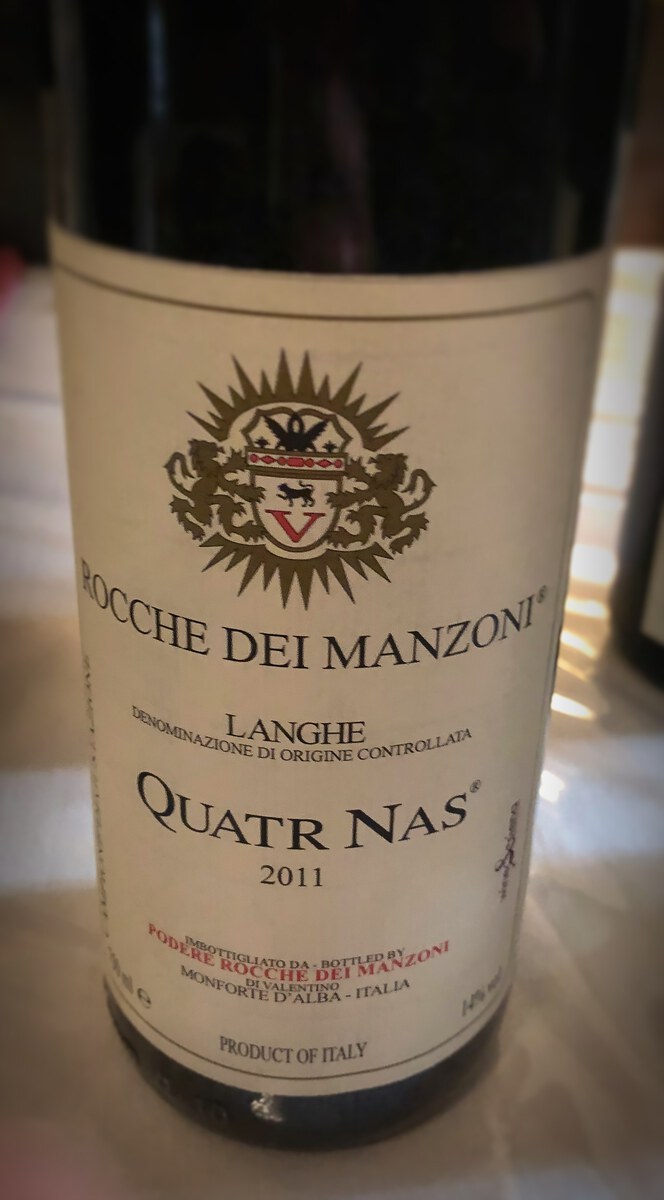Rocche dei Manzoni "Quatr Nas Langhe Rosso" 2011
Blend of Nebbiolo / Pinot noir / Cabernet Sauvignon / MerlotComplex, elegant, sumptuous. Fig leaf, coffee, toasty notes.
Tasting Notes
An elegant and long wine.
The 2011 Quatr Nas Langhe Rosso from Rocche dei Manzoni nose is very interesting with fig leaf, coffee and other toasted aromas.
On the palate, the tannins are well integrated and smooth, the acidity give it a nice nerve and promise a great potential for ageing longer.
The finish is long and elegant.
It’s a truly beautiful wine that I would definitely recommend!

|
|
Rocche dei Manzoni |
|
|
Quatr Nas Langhe Rosso |
|
|
Red & Still |
|
|
Italy |
|
|
Piemonte |
|
|
Nebbiolo, Pinot noir, Cabernet Sauvignon, Merlot |
|
|
2011 |
|
|
Learn more
Nebbiolo
Wine making grape
Nebbiolo is an Italian red wine grape variety best known for its production in the Piedmont region, where it produces the DOCG wines of Barolo, Barbaresco, Roero, Gattinara, Carema, and Ghemme. The word “nebbiolo” is thought to come from the Italian nebbia or Piedmontese nebia, which means “fog.” A thick, dense fog descends on the Langhe area, where many Nebbiolo vineyards are located, during harvest, which usually occurs in late October. Alternative interpretations include the formation of a fog-like glaucous veil over the berries as they mature, or that the name is derived from the Italian word nobile, which means noble. Nebbiolo manufactures light-colored red wines that are tannic in youth and have tar and rose scents. The wines mature to reveal other aromas and flavors such as violets, tar, wild herbs, cherries, raspberries, truffles, tobacco, and prunes as they age and take on a distinctive brick-orange hue at the rim of the bottle. To balance the tannins with other characteristics, Nebbiolo wines can take years to mature.
Link to here... | Derived from 'Nebbiolo' on WikipediaPinot noir
Red wine grape variety
Pinot noir is a type of red wine grape that belongs to the Vitis vinifera genus. It’s also probable that the name refers to wines produced mainly from Pinot noir grapes. The name comes from the words “pine” and “black” in French. The name pine refers to the grape variety’s tightly clustered, pine cone-shaped fruit bunches.
Link to here... | Derived from 'Pinot noir' on WikipediaCabernet Sauvignon
Red-wine variety of grape
Cabernet Sauvignon is one of the most well-known red wine grape varieties in the world. It is grown in nearly every major wine-producing region, in a wide range of climates, from the Okanagan Valley in Canada to the Beqaa Valley in Lebanon. Cabernet Sauvignon rose to popularity as a result of its use in Bordeaux wines, where it is often blended with Merlot and Cabernet Franc. The grape spread through Europe and into the New World, settling in places like California’s Santa Cruz Mountains, Paso Robles, Napa Valley, Hawkes Bay, South Africa’s Stellenbosch region, Australia’s Margaret River and Coonawarra valleys, and Chile’s Maipo Valley and Colchagua. It was the world’s most widely planted premium red wine grape for most of the twentieth century, before Merlot overtook it in the 1990s. By 2015, however, Cabernet Sauvignon had reclaimed its place as the most widely planted wine grape, with 341,000 hectares (3,410 km2) under vine globally.
Link to here... | Derived from 'Cabernet Sauvignon' on WikipediaMerlot
Dark blue-colored variety of wine-making grape
Merlot is a dark blue–colored wine grape variety that can be used to produce both blending and varietal wines. Merlot is thought to be a diminutive of merle, the French word for a blackbird, which is most likely a reference to the grape’s color. Merlot is a common grape for blending with the sterner, later-ripening Cabernet Sauvignon, which appears to be higher in tannin, due to its softness and “fleshiness” combined with its earlier ripening.
Link to here... | Derived from 'Merlot' on Wikipedia
